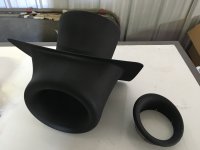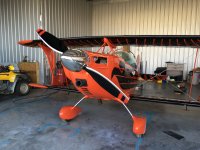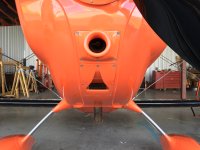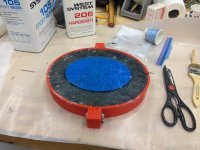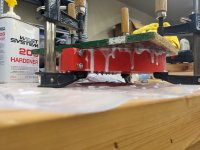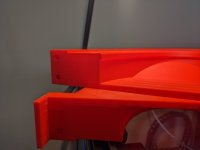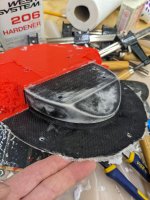rmartingt
Well Known Member
I'm getting closer to finished with my build, with about 20% of the remaining work being FWF and 75% being fiberglass (shudder). One area where these intersect is my snorkel--thanks to having an SDS throttle body and a Superior cold sump, my geometry is all screwy and I need to fab a custom intake snorkel.
Accordingly, I mocked up a blue foam mold, coated it in tape, and started laying up glass, but fiberglass and I really don't get along. It's a nightmare, and I've been looking for ways to farm out the remaining glass work (fab, fill, and finish) in the interest of finishing this coming year and preserving my sanity.
While relating all this over coffee the other day, a good friend and former coworker suggested "well why don't you just 3D print that part? I'm sure you'd enjoy that process a lot more...". And so I got to thinking...
I see two big obstacles; first, I have no good way of precisely modeling the part short of a 3D scanner. Now, the last one I used was in 2008 and back then it was $80,000, but now it appears they've come way down in price just like printers. So, does anyone have recommendations on a scanner that would work around the underside of a Lycoming? Relative positioning of the ends is the really hard part to handle; I can get good measurements of the throttle body and the filter/flange area and model those properly.
Second is materials. I know my little Ender 3 can't handle the materials I'd need, but I suspect there are some high-temperature-tolerant materials that would work provided I protect enough against radiant heat from the exhaust. Anyone have suggestions here on a material/supplier?
Or am I just way off my rocker on all this?
Accordingly, I mocked up a blue foam mold, coated it in tape, and started laying up glass, but fiberglass and I really don't get along. It's a nightmare, and I've been looking for ways to farm out the remaining glass work (fab, fill, and finish) in the interest of finishing this coming year and preserving my sanity.
While relating all this over coffee the other day, a good friend and former coworker suggested "well why don't you just 3D print that part? I'm sure you'd enjoy that process a lot more...". And so I got to thinking...
I see two big obstacles; first, I have no good way of precisely modeling the part short of a 3D scanner. Now, the last one I used was in 2008 and back then it was $80,000, but now it appears they've come way down in price just like printers. So, does anyone have recommendations on a scanner that would work around the underside of a Lycoming? Relative positioning of the ends is the really hard part to handle; I can get good measurements of the throttle body and the filter/flange area and model those properly.
Second is materials. I know my little Ender 3 can't handle the materials I'd need, but I suspect there are some high-temperature-tolerant materials that would work provided I protect enough against radiant heat from the exhaust. Anyone have suggestions here on a material/supplier?
Or am I just way off my rocker on all this?



